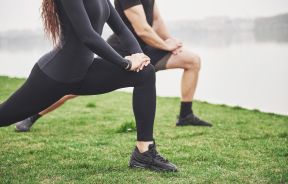Obesity Risk Decreases When Physical Activity Levels Are High And Time Spent Sitting Around Is Low

Obesity cannot be defeated with a single fad diet, body-changing workout, or magical pill, but instead with commitment to a new lifestyle researchers believe could be the answer. Researchers from the University College London found by combining high levels of physical activity with lower levels of time spent sitting around, the risk of obesity will drop significantly. They published their findings in Diabetologia, the journal of the European Association for the Study of Diabetes.
"The greatest reduction in risk of developing metabolic risk factor clustering observed for intermediate levels of physical activity and leisure time sitting was unexpected and suggests that moderate amounts of both moderate-to-vigorous physical activity and leisure time sitting may be sufficient to protect against developing metabolic risk factor clustering over time,” the study’s authors wrote.
Researchers analyzed data from 3,670 British government participants’ records of physical activity and the amount of their leisure time they spent sitting between 1997 and 1999. Researchers then looked at their odds of becoming obese after five years and then 10 years.
"These findings add to the literature by suggesting that the combination of high physical activity and low leisure time sitting is a stronger protective factor against becoming obese than either behavior on its own," the authors wrote.
Low levels of physical activity and high levels of sedentary sitting time, are two common life-style behaviors that when combined, are associated with obesity and the chronic diseases associated with excessive weight gain, such as type 2 diabetes, cardiovascular disease, stroke, and certain types of cancers. In the United States alone, more than one-third of adults are obese, according to the Centers for Disease Control and Prevention.
"The mechanisms underlying this interaction are unclear. In principle, lower levels of leisure time sitting may strengthen protective effects of higher physical activity, either through independent physiological mechanisms or as a marker for greater engagement in low-intensity activity, such as standing,” the researchers wrote.
By looking at the group that had low levels of physical activity coupled with high levels of leisure sitting time, it was made clear they expended the least amount of energy, which increased the chances of becoming obese. Low levels of physical activity were associated with becoming obese after 10 years, regardless of the amount of sitting time a person recorded.
However, those who had the lowest obesity risk after five years, reported the combination of high physical activity and less time spent sitting around. Physical activity and low leisure sitting time seemed to act together to create a protective and preventive effect on the body, which ultimately reduced the risk of obesity.
“The effectiveness of physical activity for preventing obesity may depend on how much you sit in your leisure time. Both high levels of physical activity and low levels of leisure time sitting may be required to substantially reduce the risk of becoming obese. Associations with developing metabolic risk factor clustering were less clear. Intervention studies are needed to examine whether a total lifestyle approach, promoting both high physical activity and low leisure time sitting, is most effective at reducing the risk of becoming obese," the researchers wrote.
Source: Bell JA, Hamer M, Batty DG, Singh-Manoux A, Sabia S, and Kivimaki M. Combined effect of physical activity and leisure time sitting on long-term risk of incident obesity and metabolic risk factor clustering. Diabetologia. 2014.



























